 Every now and then, something happens to mean that a team has to play behind closed doors. Whether it be a security risk, punishment for fan behaviour or because of a global health crisis, it is not unheard of for both club and national teams to have to play their games without supporters in attendance. Given that those supporters often claim that ‘football without fans is nothing’, it would be natural to assume that the results of matches pan out in such a way that the home team is the one that suffers in terms of results.
Every now and then, something happens to mean that a team has to play behind closed doors. Whether it be a security risk, punishment for fan behaviour or because of a global health crisis, it is not unheard of for both club and national teams to have to play their games without supporters in attendance. Given that those supporters often claim that ‘football without fans is nothing’, it would be natural to assume that the results of matches pan out in such a way that the home team is the one that suffers in terms of results.
The question is, do the stats back that notion up? Whilst it was decidedly rubbish to see football matches being played without fans in attendance during most of the 2020-2021 campaign, it did at least provide us with the perfect opportunity to explore just how important fans are the outcome of games of football. Interestingly, the 2019-2020 season was mostly played with fans before moving behind closed doors, so gives us an even more direct contrast on how matches panned out under both conditions that we can look at.
Does Playing Behind Closed Doors Increase the Chances of an Away Win?
During the 2020-21 season where the majority of games were played behind closed doors, the Premier League, Championship, League One and League Two all showed an increase in the win percentage of the away teams compared to the average of the previous four seasons (2016-17 to 2019-20).
The biggest difference came in the Premier League with the away win percentage increasing by 10% compared to the previous four seasons. This was 6.6% in League One, 4.3% in the Championship and 1.9% in League One.
What Games Were Played Behind Closed Doors?

Between the 2019-20 and 2020-21 seasons, a huge number of games throughout the Premier League and the English Football League had to take part behind closed doors or with restricted numbers in attendance. There percentage of games effected across these two seasons is shown in the table below:
Premier League & EFL Games with Attendance Restrictions
| Division | 2019-20 | 2020-21 |
|---|---|---|
| Premier League | 24.2% | 100.0% |
| Championship | 19.6% | 100.0% |
| League One | 0.0% | 100.0% |
| League Two | 0.0% | 100.0% |
2019-20
During the 2019-20 season, all four leagues were suspended in March. The Premier League and Championship resumed in July to complete their remaining fixtures without fans, meaning around 1/5 of games had to be played behind closed doors. Leagues One and Two did not resume after the March suspension meaning that although the season was curtailed, all matches that were played could be fully attended.
2020-21
For all four divisions during this season, the majority of games were held with no fans in attendance. A number of games were allowed partial attendances in December as well as a selection of matches which were used as trial events. For the Championship, League One and League Two, restrictions remained in place for the entire season. For the Premier League, the final round of fixtures were moved to allow 10,000 fans or 25% of the capacity for those ten games only. These were the only matches with a significant number of fans in the stadiums.
Premier League
The first thing to do is to have a look across five seasons of football, taking into account whether or not fans were allowed into the grounds for the matches. We will look across all four divisions of the English Football League, starting with the Premier League. Here we will be looking at the results of matches across the course of the seasons, looking at the number of home wins, the amount of away wins and the number of draws:
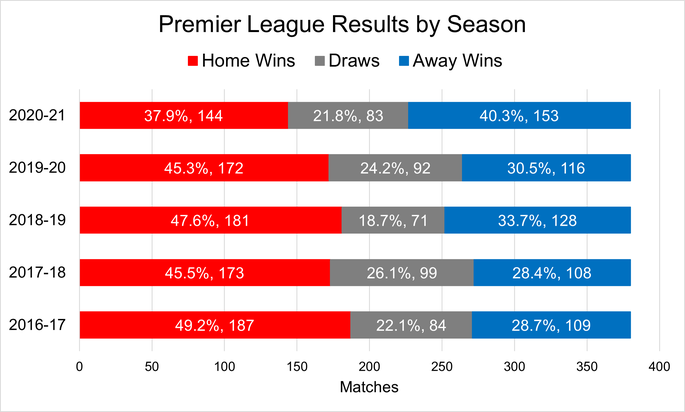
The immediate thing that jumps out is that the 2020-2021 season, which was mostly played behind-closed-doors, saw a near ten percent increase on away wins compared to seasons when crowds were allowed in throughout. Here are those away win percentages across all five seasons lined up next to each other:
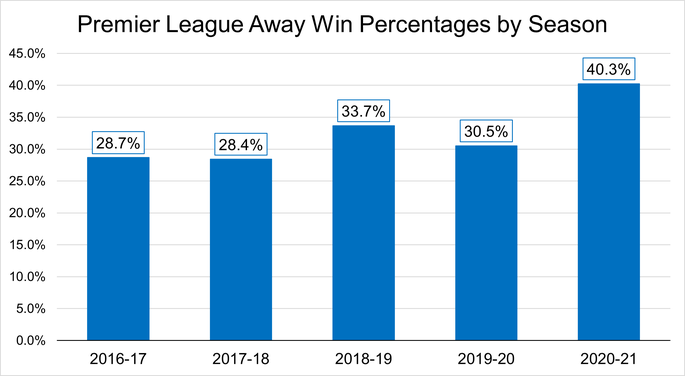
There is a clear jump in away wins for the 2020-2021 season, when no fans were allowed to attend matches for most of the campaign. Obviously that includes away supporters, but given that they tend to only make up a small percentage of the overall crowd, it is clear that losing home supporters was far more influential. We can also look at the final day of the 2020-2021 season, at which point fans were allowed back into grounds around the country. Here are the outcomes of the matches:
Premier League Results – 23rd May 2021
| Home | Score | Away | Result | Attendance |
|---|---|---|---|---|
| Arsenal | 2-0 | Brighton | Home Win | 10,000 |
| Aston Villa | 2-1 | Chelsea | Home Win | 10,000 |
| Fulham | 0-2 | Newcastle | Away Win | 10,000 |
| Leeds | 3-1 | West Brom | Home Win | 8,000 |
| Leicester | 2-4 | Tottenham | Away Win | 8,000 |
| Liverpool | 2-0 | Crystal Palace | Home Win | 10,000 |
| Manchester City | 5-0 | Everton | Home Win | 10,000 |
| Sheffield United | 1-0 | Burnley | Home Win | 8,000 |
| West Ham | 3-0 | Southampton | Home Win | 10,000 |
| Wolves | 1-2 | Manchester Utd | Away Win | 4,500 |
Out of the ten matches that took place in the final game week of the season, seven of them ended in home wins and three in away wins, with no draws. That amounts to a 70% win ratio for the home side, compared to the 45.1% average of wins for home teams that occurred across the five seasons that we’re looking at and the 37.9% wins for home sides during that campaign specifically. In other words, home advantage genuinely does make a massive difference, even more so when fans have been absent for most of the season.
Championship
The Premier League is obviously the top division of football in England. As a result of that, the teams that play in it tend to have the best footballers and, you would imagine, can best cope with the slings and arrows or outrageous fortune more readily than players in the lower tiers. In order to investigate that supposition, let’s have a look at the same information but for the Championship, the second-tier of English football:
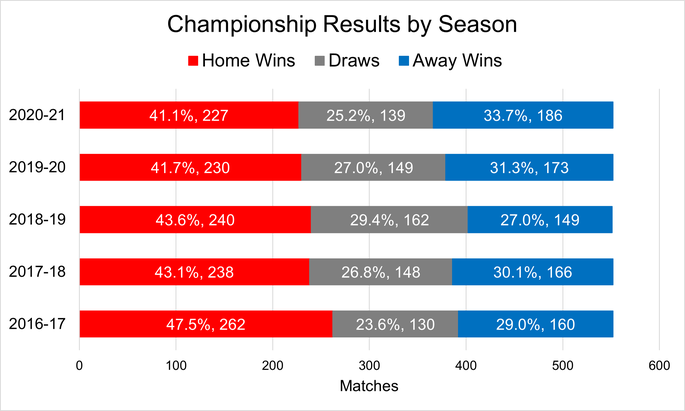
Interestingly, the number of away wins in the Championship did increase when fans were not allowed into stadiums for the majority of the 2020-2021 campaign, but the leap wasn’t as big as it had been for the Premier League. Here are those away win percentages across the five seasons side-by-side:
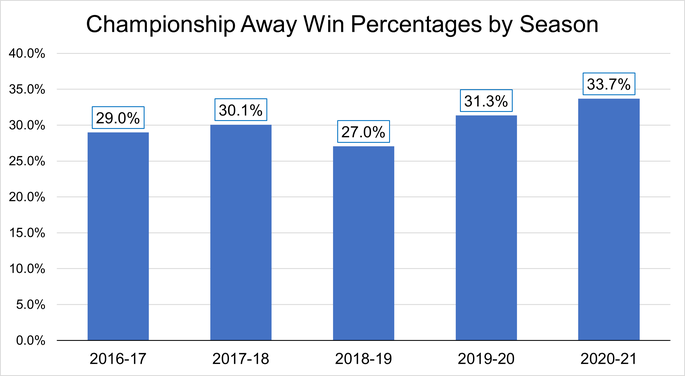
The difference between the season with the most away wins but fans in attendance all season and the away win percentage for the season that mostly didn’t have fans is 2.4%, compared to 6.6% in the Premier League. That seems to suggest that less talented players are also less influenced by the vociferousness of the supporters in attendance.
League One
In order to support our hypothesis that more talented players tend to feed off the crowd reactions more than less talented players, therefore making them more likely to lose games without the home crowd in attendance, let us now look at League One. The big difference between League One and the Premier League and Championship is that the 2019-2020 season was abandoned before completion, rather than played out behind-closed-doors.
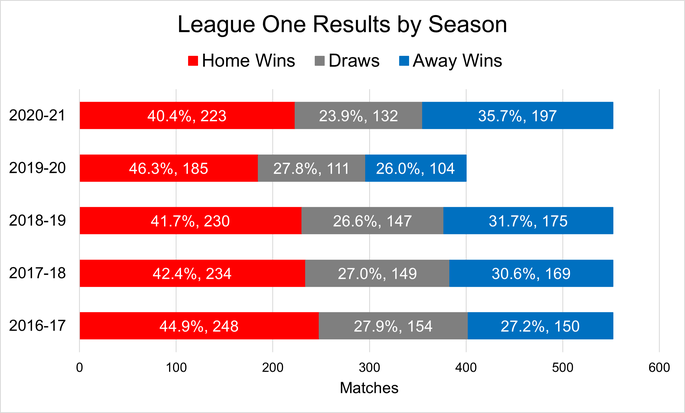
Once again, the increase in the away win percentage in the 2020-2021 season doesn’t initially seem to be as dramatic as in the Premier League, though is larger than in the Championship. Here’s a look at the away win percentages side-by-side across the five seasons of League One football:
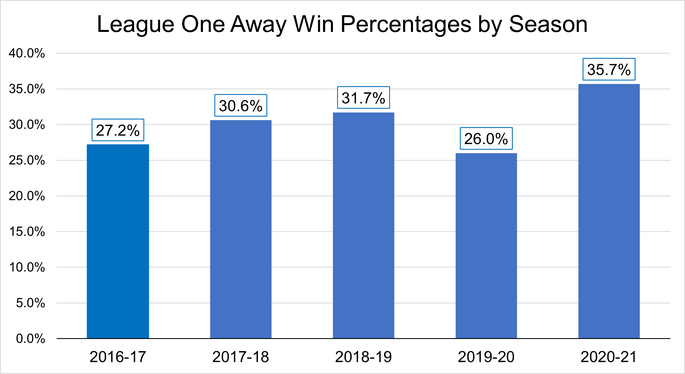
The difference between the most away wins in a season with fans in attendance and the campaign without supporters is 4.0%. That puts it broadly in-line with the Championship, with a slight lean towards the Premier League’s total, but not enough to mean that our hypothesis is in tatters.
League Two
For the sake of completeness, we will now look at the same period of time for League Two. The bottom tier of the Football League will, by definition, have the least talented players taking part in games, so does our hypothesis about the ability to adapt to no fans in attendance hold water? As with League One, the League Two season was brought to an early end in the 2019-2020 campaign.
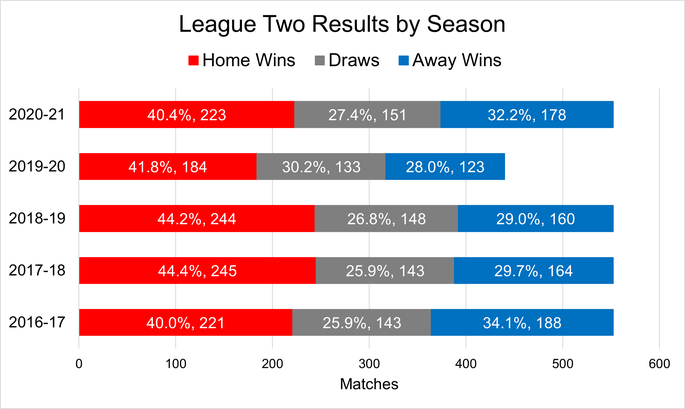
Interestingly, League Two is the first division in which the number of games won by the away team was higher in one of the seasons when fans were in attendance than when they were not. That is suggestive both of fans mattering and also League Two crowds not being as important to outcomes as other divisions. Here are the away win percentages of all five seasons alongside each other:
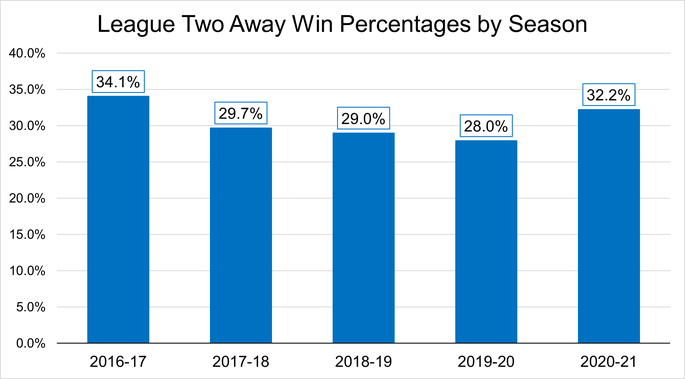
The difference between the biggest away win percentage during a campaign with fans and the 2020-2021 campaign, in which supporters were mostly absent, is -1.9%. That very much fits with our theory that players with lower ability levels can more easily cope with no fans in the ground than talented players. It is clear that players at the top-level of English football have learnt to feed off the fans, therefore meaning that the struggle to cope when those fans are missing.
What About Win Percentages?
Thus far in this piece we have looked specifically at the number of times away teams have won, as opposed to what the percentage of home wins are. In essence, the information is the same, but this does help to indicate whether or not home teams were more likely to draw or lose rather than win when supporters aren’t in the ground. Rather than go through each division one by one as we have done already, here is a summary table of the difference between the average away win percentage between the 2016-17 and 2019-20 seasons and the season without fans in 2020-21 for each division:
Away Win Percentages Compared
| Division | 2020-21 | 2016-17 to 2019-20 | Difference |
|---|---|---|---|
| Premier League | 40.3% | 30.3% | +10% |
| Championship | 33.7% | 29.4% | +4.3% |
| League One | 35.7% | 29.1% | +6.6% |
| League Two | 32.2% | 30.3% | +1.9% |
The above table does include the 2019-2020 season despite the fact that it was partially played behind closed doors in the Premier League and Championship. The first thing that you’ll notice is that the percentage difference broadly drops down with every division, with the exception on League One. This supports our hypothesis that playing behind closed doors does indeed effect the result with smaller crowds and a lower level of play reducing this effect. If you’re betting on a match behind-closed-doors then the away team stands a great chance of success than they would have if fans were present, meaning that it does indeed affect home advantage.
